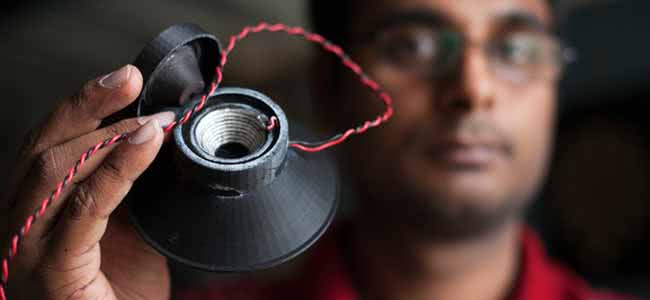2013 can definitely be remembered by music fans as the year that 3D printing broke.
The emerging industrial tech has brought a number of fascinating milestones, from fully-functioning guitars to fully fledged band’s worth of 3D printed instruments and even human prosthetic musical instruments plus reproductions of iconic album art.
There’s also been the world’s first 3D printed records and accompanying pop-up record store (with a little help from Bloc Party’s Kele Okereke) and now some smart cookies have come up with the idea of 3D printing equipment to actually play that fancy new vinyl with.
Graduate students and researchers at Cornell University’s College of Engineering have used a pair of 3D printers to produce a functional speaker, as PC Mag reports.
Hod Lipson, an associate professor mechanical and aerospace engineering, is the leader of the new project, who has designed each part of the mini speaker – from the plastic outer body to the magnet an conductive coil innards – to be ready-made to blast your favourite playlist once its come fresh from the printer by connecting to rudimentary amplifier wires on most audio systems.
Most larger 3D printed products must be pieced together, but Lipson, alongside graduate students Apoorva Kiran and Robert MacCurdy, are paving the way for products that can be fabricated in a single print, with the new speaker leading the charge.
“Many people wonder whether 3D printing has reached its peak, whether this is a hype cycle that’s now at its maximum. But really, I think we’ve only seen the tip of the iceberg of this technology,” says Professor Lipson in a video demonstrating the new printed speaker.
Love Music?
Get your daily dose of metal, rock, indie, pop, and everything else in between.
“What we’ve done here is basically print a consumer electronic device; a very simple electronic device” Lipson says. “What we’re trying to do is to move 3D printing away from just printing passive parts — made of plastic or metal — to printing integrated systems, active systems that can do something; they have batteries, wires, [and] electronics in them.”
Lipson predicts that further advances will be able to print multiple working materials and processes at once, bringing the future vision of literally printing 3D working objects just that little bit closer to a reality, even if the consumer versions of this technology is still a number of years away from the everyday home.
“One of the challenges in printing electronic systems is really [a] material science challenge,” he explains, likening the process to a printer combining different colours to produce complex prints. “You can load up the printer with lots of materials, but the challenge is: are these materials mutually compatible?”
While the Cornell University team’s modest little mini-speaker is looking ahead, high-end smartphone makers HTC have already produced a consumer-ready set of 3D printed speakers, albeit it with an equally high-end price tag.
Designed exclusively for the HTC One smartphone, the Gramohorn acoustic speaker is available in two designs: a US$ 1,600 3D printed plaster version in a range of 27 colours, or a chrome looking set in three metal finishes for US$ 8,000
(Image: Jason Koski/University Photography. Source: Cornell University)

































